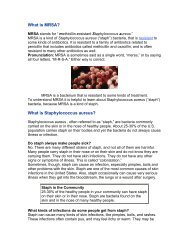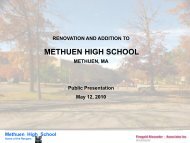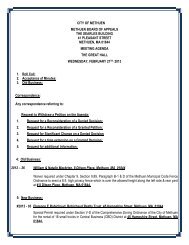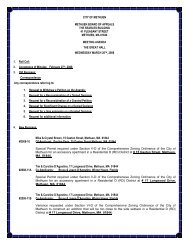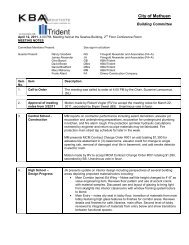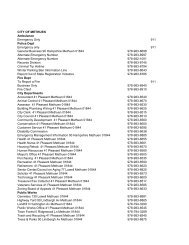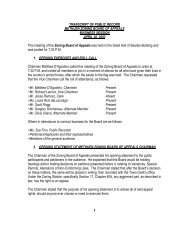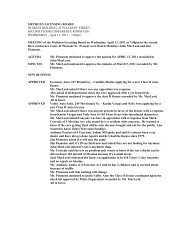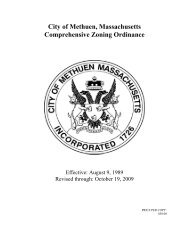City of Methuen Master Plan
City of Methuen Master Plan
City of Methuen Master Plan
Create successful ePaper yourself
Turn your PDF publications into a flip-book with our unique Google optimized e-Paper software.
Natural Resources, Open Space, and Recreation<br />
Natural Corridors<br />
Wetlands provide important “natural corridors” that can be enhanced by careful planning. <strong>Methuen</strong><br />
recognizes this potential by enforcing the 50-foot no-disturb buffer around its wetlands and reviews<br />
activities within an additional 50-foot area. The Open Space and Recreation <strong>Plan</strong> urges protection <strong>of</strong><br />
lands adjacent to already protected areas. Another strategy for improving the value <strong>of</strong> these natural<br />
corridors would be to provide developers with incentives for protecting areas adjacent to wetlands<br />
and/or providing trails along the wetlands that pass through their developments. This would be<br />
especially valuable in situations where the corridor would serve as a link between already protected<br />
parcels.<br />
<strong>Plan</strong>ning for Corridors<br />
One <strong>of</strong> the Open Space <strong>Plan</strong>’s main goals is to develop trails and greenways to link open spaces and<br />
provide access. Trails can provide a healthful alternative to driving to the market or to a nearby<br />
recreation site. Trails have also been acknowledged as an important means to help improve good health.<br />
The <strong>Master</strong> <strong>Plan</strong>’s Open Space <strong>Plan</strong> Map shows numerous potential corridors. Each <strong>of</strong> these potentials<br />
links existing open space resources with other protected land and in many cases with areas that have<br />
been designated as “priority habitats” by the state’s Natural Heritage and Endangered Species Program.<br />
Many <strong>of</strong> the proposed corridors follow already protected wetlands and stream corridors or transmission<br />
lines. Some <strong>of</strong> these corridors serve as natural linkages between larger upland and wetland areas. Not<br />
all <strong>of</strong> these corridors are suitable for trails, but many may easily provide a trail linkage if a right-<strong>of</strong>-way<br />
were negotiated with the private owners or if the dedication <strong>of</strong> a right-<strong>of</strong>-way were made a condition <strong>of</strong><br />
the properties’ development. In other cases trails can be routed along existing roads for part <strong>of</strong> their<br />
way. There may also be other potential corridors that are not identified.<br />
Many <strong>of</strong> the potential corridors connect to or cross over Chapter 61 lands. These lands have been given<br />
a reduction in their property taxes as an incentive for being used for agriculture, forest, or recreation. In<br />
addition, the city has a 120-day option to buy these lands if the current owner wishes to sell. The city<br />
should prioritize these lands in terms <strong>of</strong> their importance for inclusion in the future open space system.<br />
Their role in providing potential corridors can be one more reason for the permanent protection <strong>of</strong> at<br />
least a portion <strong>of</strong> these areas.<br />
Several <strong>of</strong> these potential corridors warrant special mention. The state and the Northern Middlesex<br />
Council <strong>of</strong> Governments have proposed a trail corridor along the northern bank <strong>of</strong> the Merrimack<br />
River. This trail would connect downstream to the ocean and upstream to the Pawtucket Boulevard<br />
greenway in Lowell and potentially along the river to Nashua. The river itself is one <strong>of</strong> the “priority<br />
habitats,” designated by the state’s Natural Heritage Program. The Spicket River <strong>of</strong>fers another<br />
potential that could connect the existing Spicket Riverwalk to the Merrimack River passing through<br />
Lawrence.<br />
Corridors and greenways are beginning to be more recognized both as a means <strong>of</strong> providing wildlife<br />
habitat and opportunities for exercise, thus contributing to both the health <strong>of</strong> the environment and to<br />
the health <strong>of</strong> people. Research is showing that when mixed with large protected areas, corridors can<br />
play an important role in preserving a diversity <strong>of</strong> wildlife. The following is a set <strong>of</strong> design guidelines to<br />
achieve these goals:<br />
• Wider is better. Corridors less than 150 feet wide do not provide meaningful wildlife<br />
habitat. Narrow corridors can be important for trail connections, but they may be<br />
inadequate for use by wildlife.<br />
Page 141



